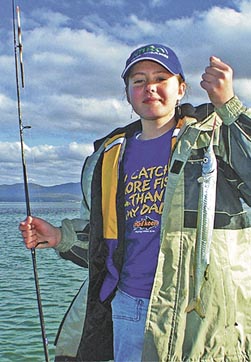 Garfish time
Garfish time
The particular species of garfish that is common to Tasmanian waters, especially during winter, is the Southern sea garfish. It is found in most Southern Australian states both in the open ocean and throughout our estuary systems. They are predominantly a herbivore and feed mainly on varying species of sea grass, algal filaments and small amounts of crustaceans. They spawn in shallow sea grass beds throughout the summer months October to March.Georges Bay becomes a hot spot for big fat XOS sized garfish from April onwards and when a hot garfish bite is on dozens of boats line up to jostle for a position along the main channel leading out to the barway
One of the most important factors to successful garfishing is the use of berley to attract the fish and keep them in the immediate vicinity of your boat. A berley mixture can be as simple as a can of cat food mixed with some bread and thrown in handfuls over the side of the boat or as elaborate as a home made concoction of fish oils, fish scraps, breadcrumbs, meal, pollard, chicken pellets and some secret herbs and spices.
One important point to be aware of with your berley is not to make the pieces too large as this will only serve to feed the fish and they will soon eat their fill and move on. By far the most effective and lethal berley I have come across is the Stimulate Ultrabite range of berley's, in particular the Ground Berley model. This is a premixed berley that is in a fine particle form that resembles breadcrumbs but has some added attractants mixed in for good measure. I mix about two handfuls of the berley mix and half a cupful of tuna oil to a berley pot and lower into the water over the side of the boat; this creates a cloud of fine particles in the water as well as an oil slick on the surface. As there are no large food items for the garfish to feed on they tend to swim around getting a good whiff of the berley and oil and become quite agitated and enter into a feeding frenzy. Provided you keep a continuous stream of this berley mixture in the water the fish will stay attracted to the area for long enough to catch your feed. A small size10-12 long shank hook under a small quill or ball float with a small piece of squid, chicken skin or anything white placed on it will result in a hooked fish.There are two other techniques for catching garfish that are becoming more and more popular and offer great sport; these are soft plastics and fly-fishing.
Small soft plastics such as No.1 Squidgy Wrigglers in drop bear, gary glitter and silver fox are very effective as are 2" Berkeley Power grubs in pumpkinseed and bloodworm also 2" Ecogear Paramax in white. Used in conjunction with a small 1 gm and 1.5 gm squidgy jig head and worked erratically through the berley trail it is a dynamite technique and a lot of fun on light tackle. The garfish can get quite aggressive once fired up with the stimulate berley and will attack the plastic lure surprisingly hard.
For those looking for a bit more of a challenge a fly rod and small flies such as Crazy Charlies and small minnow patterns in predominantly white colours will also catch fish. I have found a few retrieval techniques work with the flies, either a slow draw and stop letting the fly rise and fall in the water column or if the fish are particularly aggressive short quick strips close to the surface will draw strikes.
Garfish tend to favour areas that are shallow and have good seagrass beds, in Georges Bay the hot spot seems to be along the red channel markers leading out to the barway next to the shallow sandbank. Here you have shallow water, plenty of seagrass and on the incoming tide some good current to carry your berley trail and keep the fish swimming behind your boat. I have found that the incoming tide from about half in to full tide is about the best time to chase the gars. The garfish can often be seen swimming right up on the shallow sand flats also and large schools of fish will jump out of the water as if they are being chased by something larger.
Jamie Henderson